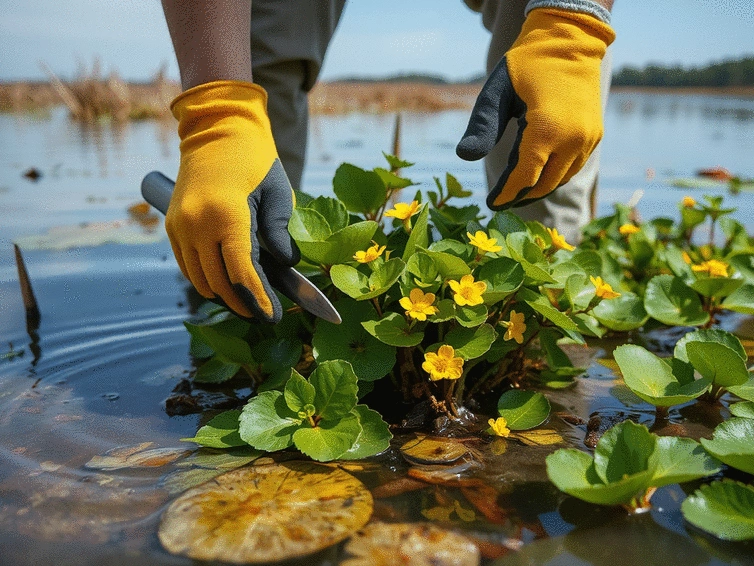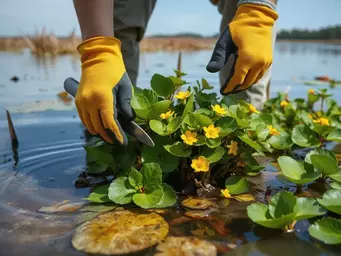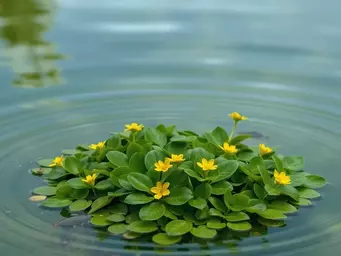Infestation & Impact
- • Outcompetes native plants, reducing biodiversity.
- • Clogs waterways, impairing flow & nutrient cycling.
- • Alters food webs & reduces oxygen levels.

Have you noticed creeping water primrose in local waterways? This invasive plant can significantly disrupt aquatic ecosystems, and understanding its biology is crucial for effective management. Dive in to uncover essential insights about this species and the strategies to mitigate its impact.
Understanding how to control Ludwigia peploides is crucial for ecosystem health. This framework outlines the key challenges and strategies involved in its management, from infestation to prevention.
As an ecologist and the founder of the Ludwigia Peploides Resource Center, I often find myself fascinated by creeping water primrose, or Ludwigia peploides. This plant is more than just an intriguing species; it plays a critical role in aquatic ecosystems. Identifying it correctly is essential for effective management. You can recognize it by its vibrant yellow flowers and oval leaves that float on the water's surface. Typically found in shallow waters, it thrives in wetlands, marshes, and riverbanks.
Understanding its growth habits is equally important. Creeping water primrose can form dense mats that quickly spread, resulting in significant impacts on its environment. Have you noticed these mats in your local waterways? This plant can rapidly propagate by both seeds and vegetative fragmentation, making it a persistent invader in many habitats.
The life cycle of creeping water primrose is intriguing. This perennial herb can grow up to 10 feet in length, with stems that can root at nodes when in contact with moist soil. Here are some key aspects of its spread:
Understanding these characteristics helps land managers and ecologists like myself develop effective control strategies to combat its spread. For more detailed information on its characteristics and impact, you can refer to resources like the LIISMA Floating Water Primrose page. Have you encountered this plant in your work? Sharing experiences can enhance our collective understanding.
Creeping water primrose poses significant environmental challenges. Its rapid growth can outcompete native vegetation, leading to reduced biodiversity. Here are some notable impacts:
By understanding these impacts, we can better appreciate the urgency of managing creeping water primrose. The City of Portland's Bureau of Environmental Services provides further insights into the ecological threats posed by Water Primrose. Have you seen similar effects in your local ecosystem? Let’s discuss how we can work together to address these challenges!
Creeping water primrose is a quintessential example of an invasive species. It fits into a broader category of plants that disrupt local ecosystems. Its effects on aquatic habitats can be profound:
Recognizing the role of creeping water primrose within the context of invasive species highlights the need for effective management strategies. Are you actively involved in managing invasive species in your area? Your input can help shape our approaches!
As we delve into the challenges associated with controlling this invasive plant, it’s crucial to understand the importance of manual removal as a part of integrated management. It may seem daunting, but with the right techniques, we can reclaim our wetlands.
When managing creeping water primrose, combining manual removal with community engagement can significantly enhance your efforts. Organizing local cleanup events not only helps in physically removing the plant but also raises awareness about invasive species and fosters a collaborative approach to ecosystem management.
When managing invasive species like creeping water primrose, there are times when herbicides can be an effective part of your strategy. Before deciding to use them, it’s vital to consider regulatory guidelines and the specific circumstances of your infestation. For instance, if the infestation is extensive, herbicides might be necessary to achieve effective control.
In certain scenarios, such as when manual removal is impractical due to the size of the infestation, herbicides can supplement your efforts. It's important to approach this option with caution, ensuring that you are adhering to local regulations and considering the potential impact on surrounding ecosystems.
By assessing these factors, you can make informed decisions about whether herbicide application is the right path for your specific conditions. Always remember to consult with local authorities or experts regarding the appropriate herbicides and their application methods.
For extensive infestations of creeping water primrose, the benefits of consulting with professionals cannot be overstated. Professional management can provide specialized knowledge and experience, which is essential in navigating the complexities of invasive species control.
Hiring professionals may lead to more successful outcomes, ultimately saving you time and resources while ensuring the health of your wetland ecosystem.
When it comes to controlling invasive species like creeping water primrose, several environmental management strategies can be employed. Each strategy has its own strengths and weaknesses, and understanding these can help you choose the best approach for your situation.
These strategies can be used individually or in combination to create a comprehensive management plan tailored to your needs. For further insights into effective invasive species management techniques, you can explore resources such as Conservation Evidence on controlling floating marsh pennywort and water primrose. By considering various approaches, you can better ensure the long-term health of your wetlands.
After tackling the current issues with creeping water primrose, it's essential to implement best practices to prevent future infestations. A proactive approach will help maintain the health of your wetland ecosystem and protect native species.
Cleaning your tools and equipment is a crucial step in preventing the spread of invasive species. Here are some tips to follow:
By following these cleaning practices, you can minimize the risk of inadvertently spreading creeping water primrose to unaffected areas.
Managing wetlands is not just about removing invasive species; it also requires continuous monitoring and strategies to maintain balance. Here are some long-term strategies to consider:
These strategies will help ensure the longevity of your management efforts, making your wetland a thriving ecosystem for years to come.
To truly protect your wetlands from invasive threats, consider adopting sustainable practices in your management approach. Here are some tips:
By focusing on sustainability, you can help ensure that your wetland remains a resilient and balanced ecosystem, capable of resisting future invasions. Remember, every effort counts in the fight against invasive species!
A: Creeping water primrose (Ludwigia peploides) is an invasive aquatic plant characterized by vibrant yellow flowers and oval leaves that float on the water's surface. It typically grows in shallow waters, wetlands, marshes, and riverbanks.
A: This plant spreads quickly through both seeds and vegetative fragmentation. Its stems can grow up to 10 feet long and root at nodes when in contact with moist soil, allowing it to form dense, expansive mats.
A: Creeping water primrose outcompetes native vegetation, reducing biodiversity, clogs waterways, impeding water flow and nutrient cycling, alters food webs, and reduces oxygen levels, all of which harm aquatic life and degrade habitats.
A: Manual removal is effective for small infestations but can be labor-intensive. Herbicides are typically considered for extensive infestations that cannot be managed manually, especially in areas critical for water quality or wildlife habitat. Always adhere to regulatory guidelines and consult experts.
A: Professional management offers specialized knowledge, advanced techniques, and expertise in assessing ecological balance and implementing integrated pest management strategies. This leads to more successful outcomes for extensive and complex infestations, saving time and resources while protecting wetland health.
A: Key prevention strategies include thoroughly cleaning tools and equipment to avoid spreading plant fragments, regularly monitoring native vegetation for signs of re-infestation, implementing community education programs, and promoting biodiversity through native plant restoration and sustainable land use practices.
Here is a quick recap of the important points discussed in the article:
Genetic Insights in Ludwigia peploides
![Genetic Diversity and Hybridization in Ludwigia peploides: Insights from Chromosome Studies[3][4]](https://ludwigiapeploides.com/img/zpPCPoLYsB-UL_IMAGEUz4Hla-t.webp)
What if understanding the genetic diversity of a plant species could hold the key to preserving enti
Manual Removal of Water Primrose

Have you noticed creeping water primrose in local waterways? This invasive plant can significantly d
Ludwigia Peploides and Biodiversity Impact

As we grapple with the complexities of our ecosystems, understanding specific species like Ludwigia
Genetic Insights in Ludwigia peploides
Manual Removal of Water Primrose
Ludwigia Peploides and Biodiversity Impact
Ludwigia Peploides Reproduction Explained
Ludwigia peploides Control Methods Explained